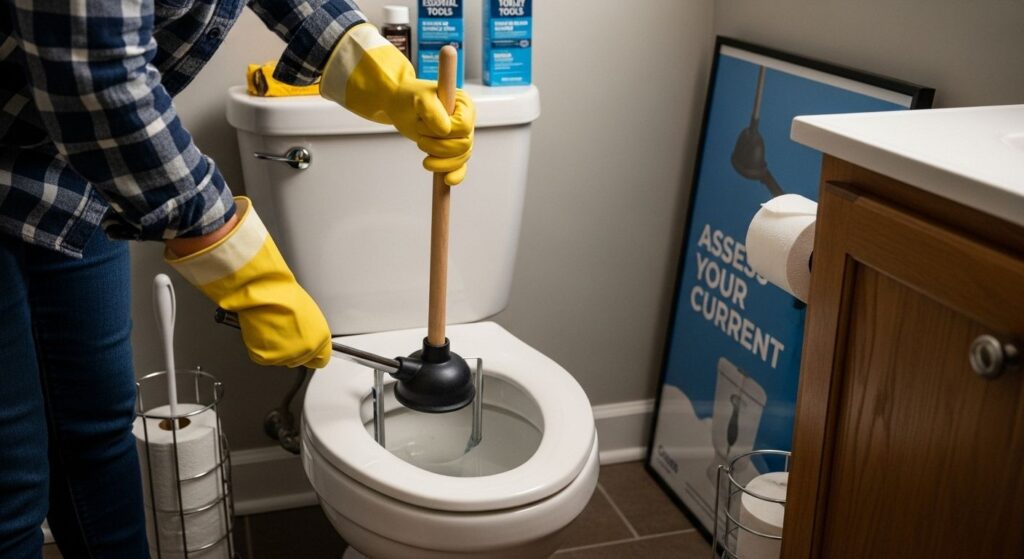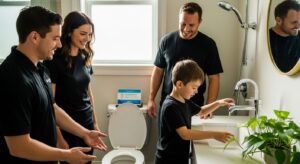Clogged toilets can turn a normal day into a stressful mess. Nobody expects that the average home may deal with up to five toilet blockages per year. Most people think a quick plunge is all it takes and they’re good to go. The truth is skipping a proper assessment and missing the right tools can make things much worse in minutes.
Table of Contents
- Step 1: Assess Your Current Toilet Situation
- Step 2: Gather Essential Tools and Supplies
- Step 3: Attempt a Plunger Solution
- Step 4: Use a Toilet Auger for Deeper Clogs
- Step 5: Test for Proper Drainage
- Step 6: Call a Professional if Necessary
Quick Summary
| Key Point | Explanation |
|---|---|
| 1. Assess water level for blockages | Check the toilet’s water level to identify serious blockages that require immediate action to avoid overflow. |
| 2. Gather essential unclogging tools | Prepare a sturdy plunger, rubber gloves, and towels to effectively address clogs without unnecessary mess. |
| 3. Use proper plunging techniques | Ensure you cover the plunger head with water and apply firm, rhythmic plunges to dislodge blockages effectively. |
| 4. Employ a toilet auger for stubborn clogs | If plunging fails, a toilet auger can reach deeper into pipes to break up harder-to-reach obstructions. |
| 5. Call a plumber if problems persist | Seek professional help for persistent clogs, sewage backups, or if multiple drains are affected, indicating complex plumbing issues. |

Step 1: Assess Your Current Toilet Situation
Before diving into clogged toilet solutions, understanding your specific plumbing situation is crucial. A thorough initial assessment can save you time, prevent potential water damage, and determine the most effective approach to resolving your toilet blockage.
Start by observing the water level in your toilet bowl. An unusually high water level often indicates a serious blockage that requires immediate attention. If water is rising close to the rim or appears stagnant, stop any additional flushing to prevent potential overflow. Learn more about emergency toilet repairs before the situation escalates.
Next, carefully examine the nature of the blockage. Are you experiencing a complete obstruction where no water moves, or a partial clog where water drains slowly? Different blockage types require different strategies. A complete blockage might suggest a significant foreign object is trapped, while slow drainage could indicate accumulated organic material or mineral buildup.
Prepare your workspace by gathering essential tools before attempting any unclogging method. Your emergency toolkit should include:
- A sturdy plunger with a good seal
- Rubber gloves for hygiene protection
- Bucket for potential water management
- Old towels or rags for cleanup
According to Florida Atlantic University, avoid flushing additional water or materials that might worsen the blockage. Patience and careful observation are key to successfully resolving your toilet issue without causing further complications.
To efficiently resolve a clogged toilet, ensure you have the following essential tools and know their primary use. This table helps you quickly check your toolkit before starting any unclogging procedure.
| Tool/Supply | Specification/Type | Purpose/Use |
|---|---|---|
| Plunger | Flange-style | Create seal and dislodge clogs |
| Rubber gloves | Thick, waterproof | Hygienic protection for hands |
| Bucket | Large plastic | Manage excess or dirty water |
| Towels/rags | Old or disposable | Clean up spills and water on floor |
| Toilet auger | With protective sleeve | Clear deeper or stubborn obstructions |
| Enzyme drain cleaner | Toilet-safe, enzyme-based | Break down organic blockages (optional) |
| Protective eye wear | Safety goggles | Prevent splash-related accidents |
By methodically assessing your toilet’s current condition, you set the stage for a targeted and effective unclogging strategy, minimizing potential damage and increasing your chances of a quick resolution.
Step 2: Gather Essential Tools and Supplies
Successful toilet unclogging depends on having the right tools and supplies prepared before you begin. Professional plumbers understand that a well-equipped homeowner can often resolve minor blockages quickly and efficiently without requiring immediate professional intervention.
Your primary toolkit should include a high-quality plunger specifically designed for toilets. Not all plungers are created equal. Look for a flange-style plunger with an extended rubber lip that creates a tight seal around the toilet bowl’s drain opening. This design allows for maximum suction and pressure, which is critical for dislodging stubborn blockages.
In addition to a plunger, gather protective gear and supplementary tools. Thick rubber gloves are essential for maintaining hygiene and protecting your hands from potential bacterial exposure. Old towels or disposable rags will help manage any potential water spillage or mess. Consider having a large bucket nearby to dispose of excess water if needed.
For more complex blockages, you might want to include supplementary tools such as:
- A toilet auger (plumbing snake)
- Enzyme-based drain cleaner
- Plastic bucket
- Protective eye wear
- Extra disposable gloves
According to InterNACHI, proper tool selection and preparation can significantly reduce the risk of additional plumbing damage during unclogging attempts. Check out our guide on toilet maintenance to understand more about long-term plumbing care.
Before starting, ensure all your tools are easily accessible and positioned near the toilet. Arrange them in a way that allows quick, efficient movement. Having everything within arm’s reach prevents unnecessary delays and reduces stress during the unclogging process. Remember, preparation is half the battle when dealing with household plumbing challenges.
Step 3: Attempt a Plunger Solution
The plunger is your first line of defense against a stubborn toilet clog. A strategic plunging technique can often resolve blockages without requiring more invasive methods. Begin by ensuring you have a flange-style plunger that creates a tight seal around the toilet bowl’s drain opening.
Before plunging, add enough water to the bowl to cover the plunger head completely. This water helps create the necessary suction to dislodge the blockage. Position the plunger directly over the drain hole, making sure the rubber flange is fully extended to create a complete seal. Maintain a vertical position to maximize downward pressure and prevent water from splashing.
Execute a series of firm, consistent plunges using a rhythmic up and down motion. Start with gentle pushes to expel air and create a strong seal, then increase the force of your plunges. Aim for 10 to 15 consecutive plunges, maintaining a steady, controlled rhythm. The goal is to create enough pressure to push or pull the obstruction through the drain.
Pay attention to how the water responds during plunging. A successful technique will typically result in one of two outcomes:
- The water level gradually begins to drop
- You hear a distinctive gurgling sound indicating the blockage is moving
Our expert guide on blocked toilets provides additional insights into advanced plunging techniques. According to University of Colorado Boulder, avoid using chemical drain cleaners, as they can damage your plumbing and are often ineffective against solid blockages.
After completing your plunging session, flush the toilet to verify if the blockage has been cleared. If water flows normally and the bowl empties without rising, you have successfully resolved the clog. However, if the water level remains high or the blockage persists, prepare to move to more advanced unclogging methods.
Step 4: Use a Toilet Auger for Deeper Clogs
When a plunger fails to clear your toilet blockage, a toilet auger becomes your next strategic tool. This specialized instrument can reach deeper into the toilet trap and break up more stubborn obstructions that a plunger cannot dislodge. Professional plumbers recommend using an auger when initial plunging attempts have proven unsuccessful.
Begin by positioning the auger’s cable directly into the toilet bowl, ensuring the protective sleeve covers the porcelain to prevent scratching. Slowly extend the cable into the drain opening, applying gentle but consistent pressure. Rotate the handle clockwise as you push the cable forward, which helps the auger navigate through pipe curves and potential blockage points.
As you maneuver the auger, you might encounter resistance. This is normal and indicates you are approaching the obstruction. Apply steady, controlled pressure while continuing to rotate the handle. The goal is to either push the blockage through or break it into smaller, passable pieces. Avoid using excessive force, which could potentially damage your toilet’s internal plumbing.
Watch for these critical indicators during the augering process:
- Sudden release of tension suggesting the blockage has been cleared
- Gradual lowering of water level in the toilet bowl
- Feeling the auger cable move more freely through the pipe
Learn more about professional drain clearing techniques that can help prevent future clogs. According to MedlinePlus, using an auger carefully can effectively resolve toilet blockages without requiring extensive plumbing intervention.
After successfully working the auger through the blockage, slowly retract the cable while continuing to rotate. Flush the toilet to verify the clog has been completely removed. If water flows normally and the bowl empties without issues, you have successfully cleared the obstruction. However, persistent problems may indicate a more complex plumbing issue requiring professional assistance.

Step 5: Test for Proper Drainage
After attempting to clear your toilet clog, thorough drainage testing is crucial to confirm you have successfully resolved the blockage. This final verification step ensures your plumbing system is functioning correctly and prevents potential future complications.
Initiate the testing process by carefully flushing the toilet. Observe the water flow closely during this initial flush. A successfully cleared toilet will demonstrate smooth, uninterrupted water drainage with the bowl emptying completely and refilling normally. Watch for any signs of hesitation, slow drainage, or water rising unexpectedly, which might indicate the blockage remains partially unresolved.
After you have attempted to clear a clogged toilet, use the checklist below to confirm whether you have achieved proper drainage and resolved the blockage. This simple table captures the key signs to look for during your test.
| Drainage Test Step | What to Look For | Pass/Fail |
|---|---|---|
| 1. Flush toilet | Water flows and empties smoothly | |
| 2. Observe water level | Water refills to normal resting level | |
| 3. Check for gurgling sounds | No unusual noises from bowl or pipes | |
| 4. Second test flush | Continues to drain rapidly | |
| 5. Check for backup | No water rising or backing up |
If the first flush appears normal, perform a second test flush to further validate the drainage. This double-check helps confirm that your previous unclogging efforts were comprehensive. Pay particular attention to the water’s movement speed and volume. Rapid, complete drainage signals that your plumbing is functioning optimally.
Potential outcomes to monitor during your drainage test include:
- Smooth, quick water movement
- Complete bowl emptying
- Normal water refill level
- No unusual gurgling sounds
- No water backing up
Explore our comprehensive plumbing maintenance strategies to prevent future blockages. While performing your drainage test, remain vigilant for any subtle indicators of ongoing issues. Persistent slow drainage or recurring blockages might suggest a more complex plumbing problem requiring professional intervention.
Should your drainage test reveal continued problems, do not hesitate to contact a professional plumber. Repeated blockages could indicate deeper systemic issues within your home’s plumbing infrastructure that require specialized diagnostic tools and expert assessment. Remember, early detection and professional consultation can prevent more extensive and expensive repairs down the line.
Step 6: Call a Professional if Necessary
Despite your best efforts, some toilet clogs require professional intervention. Recognizing when to call an expert can save you from potential extensive and costly plumbing damage. Professional plumbers possess specialized tools and diagnostic capabilities that go beyond typical household solutions.
Critical indicators that signal the need for professional assistance include persistent blockages that resist multiple unclogging attempts, water backing up into other household drains, or unusual gurgling sounds emanating from your plumbing system. These symptoms often suggest more complex issues lurking within your home’s drainage infrastructure that cannot be resolved through standard DIY methods.
Before contacting a professional, compile essential information to help them diagnose the problem quickly. Prepare details about your previous unclogging attempts, the frequency of the issue, and any observed changes in your toilet’s performance. Documenting these specifics can help the plumber understand the situation more comprehensively and potentially reduce diagnostic time.
Key situations warranting immediate professional intervention include:
- Sewage backup or foul odours
- Multiple toilets or drains experiencing simultaneous blockages
- Water levels rising unexpectedly during flushing
- Visible pipe damage or potential structural issues
- Recurring clogs despite repeated unclogging attempts
Discover the differences between DIY and professional plumbing solutions to make an informed decision. According to the Better Business Bureau, professional intervention becomes crucial when safety, health, and home comfort are potentially compromised.
When selecting a plumber, prioritize licensed professionals with proven expertise. Request transparent pricing, ask about warranties, and ensure they can provide prompt service. A reputable plumber will not only resolve your immediate toilet clog but also help prevent future plumbing complications through comprehensive diagnostic and preventative strategies.
Ready for Fast, Reliable Clogged Toilet Solutions in Ottawa?
Are you feeling the stress of a blocked toilet refusing to clear no matter how carefully you assess the situation or try different tools? Many Ottawa homeowners end up frustrated after plunging or using an auger without success. If you are worried about water damage, repeated backups, or you are simply anxious for a hygienic solution right away, you are not alone. Struggling with sudden plumbing issues is overwhelming, especially when you just want things back to normal quickly and safely. Find out how our experts help with urgent toilet and drain problems.

Why wait for messy complications or risk further damage to your home? Delta Plumbers offers 24/7 help for clogged toilet emergencies and ongoing plumbing services you can trust. Our team responds the same day, every day. We combine flat-rate pricing and a one-year warranty for peace of mind. If your efforts have not worked or you just want the fastest path back to comfort, contact us now for prompt, professional service.
Frequently Asked Questions
How can I tell if my toilet is clogged?
You can tell your toilet is clogged if the water level in the bowl is unusually high, water drains slowly, or there is no drainage at all after a flush.
What tools do I need to clear a clogged toilet?
Essential tools for clearing a clogged toilet include a flange-style plunger, rubber gloves, a bucket for managing water, and old towels for cleanup. A toilet auger may also be necessary for deeper clogs.
What should I do if plunging doesn’t work?
If plunging doesn’t clear the clog, use a toilet auger to reach deeper into the pipes and potentially break up stubborn blockages. Rotate the auger while pushing to effectively navigate through the plumbing.
When is it time to call a professional plumber for a clogged toilet?
Call a professional plumber if multiple attempts to unclog the toilet are unsuccessful, if there are simultaneous blockages in other drains, or if you notice unusual gurgling sounds, as these may indicate more serious plumbing issues.









